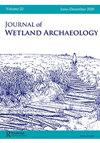蔑视的湿地:探索大沼泽中非洲裔美国人的抵抗
Q1 Arts and Humanities
引用次数: 4
摘要
摘要弗吉尼亚州和北卡罗来纳州的大沼泽地(美国)是被剥夺权利的美洲原住民、被奴役的运河公司劳工和马龙人(“丑陋的奴隶”)的家园,他们在湿地中暂时和长期生活。本文讨论了弗吉尼亚州最近对威廉姆森北部和威廉姆森南部遗址的勘探和发掘方法和结果。公开可用的激光雷达数据和地面勘探有助于在人迹罕至的景观中识别潜在的考古遗址和微妙的地形特征。通过研究沼泽这个名字所包含的当地的变化以及潮湿和干燥空间之间的联系,我们有可能看到一个更微妙的历史景观。Great Dismal Swamp国家野生动物保护区最新确定的地点表明,在我们努力了解马龙派创造的抵抗景观时,不应忽视沼泽中最小的岛屿及其周围的潮湿地区。本文章由计算机程序翻译,如有差异,请以英文原文为准。
Wetlands in Defiance: Exploring African-American Resistance in the Great Dismal Swamp
ABSTRACT The Great Dismal Swamp of Virginia and North Carolina (US) was home to disenfranchised Native Americans, enslaved canal company labourers and Maroons (‘fugitive slaves’) who lived in the wetlands temporarily and long term ca. 1607–1863. This paper discusses the methods and results of recent exploration and excavation in Virginia on the Williamson North and Williamson South sites. Publicly available LiDAR data and on-the-ground exploration facilitated identification of both potential archaeological sites and subtle terrain features across the rather inaccessible landscape. By studying the local place variations and connections between wet and dry spaces subsumed under the Swamp moniker, it is possible to glimpse a more nuanced historical landscape. Newly identified sites in the Great Dismal Swamp National Wildlife Refuge demonstrate that the smallest islands in the Swamp and the wet areas surrounding them should not be overlooked as we work to understand the landscape of resistance created by Maroons.
求助全文
通过发布文献求助,成功后即可免费获取论文全文。
去求助
来源期刊

Journal of Wetland Archaeology
Arts and Humanities-Archeology (arts and humanities)
CiteScore
1.40
自引率
0.00%
发文量
6
期刊介绍:
The Journal of Wetland Archaeology publishes a wide range of contributions in all fields of wetland archaeology. It includes scientific and methodological features, geoprospection, environmental reconstruction, wetland hydrology, cultural aspects of wetland archaeology, as well as conservation, site management, legislation, and site protection. All periods and all geographic regions are covered.
 求助内容:
求助内容: 应助结果提醒方式:
应助结果提醒方式:


